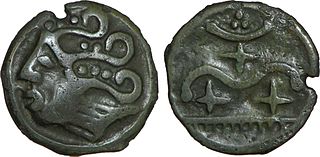
The Bodiocasses or Baiocasses were an ancient Gallic tribe of the Roman period. They were a tribal division of the civitas of the Lexovii, in the Roman province of Gallia Lugdunensis.

The Bodiocasses or Baiocasses were an ancient Gallic tribe of the Roman period. They were a tribal division of the civitas of the Lexovii, in the Roman province of Gallia Lugdunensis.
They are mentioned as Bodiocasses by Pliny (1st c. AD), [1] Ou̓adikássioi (Οὐαδικάσσιοι) by Ptolemy (2nd c. AD), [2] Baiocassi by Ausonius (4th c. AD), [3] and as Baiocas in the Notitia Dignitatum (5th c. AD). [4] [5]
The Gaulish ethnonym Bodiocasses derives from the Proto-Celtic stem *bodyo- ('yellow, blond'; cf. Old Irish buide 'yellow'). [6] [7] The meaning of the second element -casses, attested in other Gaulish ethnonyms such as Durocasses , Sucasses , Tricasses , Veliocasses or Viducasses , has been debated, but it probably signifies '(curly) hair, hairstyle' (cf. Old Irish chass 'curl'), perhaps referring to a particular warrior coiffure. Rudolf Thurneysen has compared the name with the Old Irish buide-chass ('blond curls'), and suggested to translate Bodiocasses as 'those who have blond curls/braids'. [8] Patrizia de Bernardo Stempel has proposed to interpret the name as 'those with shining helmets'. [9]
The city of Bayeux, attested ca. 400 AD as civitas Baiocassium ('civitas of the Baiocasses'; Baiocas in 400–410, Baieus in 1155), and the region of Bessin, attested in 840 AD as pagus Baiocassinus ('pagus of the Baiocasses'; Beissin in 1050–66), all stem from the Gallic tribe. [10]
The Baiocasses dwelled in a region located around modern-day Bayeux in western Normandy. [6]
Julius Caesar does not mention the Baiocasses in his commentaries on the Gallic Wars (58–50 BCE), but they are listed in the Notitia dignitatum and are probably the same people Pliny calls Bodiocasses. [11] [6]
The Baiocasses minted base gold, silver and billon (base silver) coins in the denomination of one stater and in the case of gold coins sometimes quarter staters. Most of the coins show a Celtic-style male head with elaborated hair on the obverse, and on the reverse a horse with a chariot rider above or behind, and below usually either a lyre or small boar. A number of these are in existence. [12]
The 4th-century Bordelaise poet Ausonius teases a friend as a Baiocassis who claimed to be of druidic heritage and descended from priests of Belenus. [13]

The Bituriges Cubi were a Gallic tribe dwelling in a territory corresponding to the later province of Berry, which is named after them, during the Iron Age and the Roman period. They had a homonym tribe, the Bituriges Vivisci, in the Bordelais region, which could indicate a common origin, although there is no direct evidence of this.

The Carnutes or Carnuti, were a Gallic tribe dwelling in an extensive territory between the Sequana (Seine) and the Liger (Loire) rivers during the Iron Age and the Roman period.
The Viducassēs were a Gallic tribe dwelling in the modern Calvados department during the Iron Age and the Roman period.

The Venetī were a Gallic tribe dwelling in Armorica, in the northern part of the Brittany Peninsula, during the Iron Age and the Roman period.

The Vellavii were a Gallic tribe dwelling around the modern city of Le Puy-en-Velay, in the region of the Auvergne, during the Iron Age and the Roman period.

The Aulerci Cenomani were a Gallic tribe dwelling in the modern Sarthe department during the Iron Age and the Roman period. The Cenomani were the most powerful of the Aulerci tribes.

The Parisii were a Gallic tribe that dwelt on the banks of the river Seine during the Iron Age and the Roman era. They lived on lands now occupied by the modern city of Paris, whose name is derived from the ethnonym.

The Lemovīcēs were a Gallic tribe dwelling in the modern Limousin region during the Iron Age and the Roman period.

The Osismii, Ossismii, or Ostimii were a Gallic tribe dwelling in the western part of the Armorican Peninsula during the Iron Age and the Roman period.
The Alauni were a Gallic tribe dwelling around the lake Chiemsee during the Roman period.

The Eburovīcēs or Aulercī Eburovīcēs were a Gallic tribe dwelling in the modern Eure department during the Iron Age and the Roman period. They were part of the Aulerci.
The Latobici or Latovici were a Celtic tribe dwelling in Pannonia Superior, around present-day Drnovo (Slovenia), during the Roman period.

The Redones or Riedones were a Gallic tribe dwelling in the eastern part of the Brittany peninsula during the Iron age and subsequent Roman conquest of Gaul. Their capital was at Condate, the site of modern day Rennes.
The Tricasses were a Gallic tribe dwelling on the upper Seine and the Aube rivers during the Roman period. Until the first century AD, they were probably reckoned among the Senones.

The Gabali were a Gallic tribe dwelling in the later Gévaudan region during the Iron Age and the Roman period.
The Veliocasses or Velocasses were a Belgic or Gallic tribe of the La Tène and Roman periods, dwelling in the south of modern Seine-Maritime and in the north of Eure.

The Durocasses were a Gallic tribe dwelling around present-day Dreux during the Roman period.
The Silvanectes were a small Belgic tribe dwelling around present-day Senlis (Oise) during the Roman period.
The Ambisontes were a Gallic tribe dwelling in the upper Salzach valley during the Roman period.
The Licates were a Gallic tribe dwelling in the upper valley of the Lech river during the Iron Age and the Roman period.